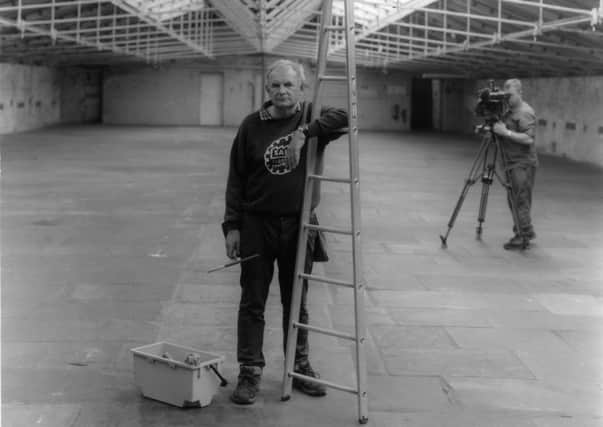Weaving together a story of industry at Bradford's Salts Mill


In the mid-1980s, Ian Beesley was a familiar figure around Salts Mill. The photographer had been commissioned by Colin Ford, who was director of what was then the National Museum of Film, Photography and Television in Bradford to complete a study of West Yorkshire’s woollen and textile industry and the famous mill at Saltaire was a natural place to start.
“I began taking pictures up there in 1985,” says Bradford-born Ian. “It was a fascinating place and I loved observing what was going on, but there was also a sense that you were capturing a moment in history. The place was gradually being shut down and, over the course of a year, I saw these great big spaces which had been filled with workers suddenly empty.”
Advertisement
Hide AdAdvertisement
Hide AdBy 1986, Salts Mill had closed and, after an exhibition of his work at what is now the National Science and Media Museum, Ian packed his images away and all but forgot about them. As his photographic work took him to all four corners of Yorkshire and beyond, things were changing too at Salts Mill.
The year after its closure, it was sold to Bradford entrepreneur Jonathan Silver who embarked on a major renovation and redevelopment scheme. Many doubted his wisdom. However, Silver, who had begun his career in retail, ignored those who suggested the only sensible thing to do was level the place and begin again.
Instead, he, along with his wife, Maggie, began making good on those ambitious plans and, as a result, opened a new chapter for the site which had first been built by the industrialist and philanthropist Titus Salt.
Thirty years on, Salts Mill is home to galleries celebrating the work of David Hockney, shops showcasing the best of contemporary design and a number of textile businesses. Keen to mark the landmark anniversary, the Silver family approached Ian about a possible exhibition and it was then that he remembered his stash of images.
Advertisement
Hide AdAdvertisement
Hide Ad“I knew I had some photographs of the mill buildings, but even I was surprised by just how many I had taken,” says Ian. “We were all keen to compare and contrast how the site has changed, so over the last few months I have taken a series of new images, again in black and white, to capture the Salts Mill of today.”
For the exhibition, Ian has been working alongside frequent collaborator Ian McMillan, who has written a series of new poems to accompany the photographs. The words and images are now being shown alongside each other in the roof space – at almost a quarter of a mile long, the room was once said to be the longest in the world.
“Many of Ian’s images are more than 6ft wide and suspended from the Victorian iron rafters it looks visually stunning,” says Zoe Silver, daughter of Jonathan. “When my father got the keys to the building I was 11 years old. My very first memories are of big empty office spaces and the smell of damp stationery. I loved it and for a while this place was our playground.
“Dad wanted to breathe art, love, and life into the rapidly deteriorating building and 30 years on we wanted to pay tribute to everyone who helped him achieve his vision and who are now carrying on that legacy.”
Advertisement
Hide AdAdvertisement
Hide AdMany of Ian’s new pictures were shot in the same spaces as the old ones, with the same camera he used three decades ago. One photograph from 1986 shows a boiler-suited quartet dismantling the very last loom in the building; his shot from today shows the space gleaming white as the canteen of a tech company. Another image shows the weaving shed standing almost empty; today it houses a production line at the cutting edge of technology. He has also shot new portraits of Salts stalwarts such as Paul Heaton, the window cleaner of 30 years standing and Dave Birkett, the resident builder and roof-roamer.
Zoe Silver says: “When I first saw Ian’s photographs from 30 years ago I found them really moving as they absolutely captured the end of one era just before the beginning of another. For a lot of people Salts Mill is about the shops and the galleries. That’s great, but there is also another side to this building. When my father bought the site he was really keen that it stay a place of work and this exhibition is partly our way of saying thank you to those firms who took a leap of faith and came with us.
“What I really love about Ian’s images is that often at first glance you wouldn’t be able to tell whether they were taken in the 1980s or now. It’s only when you look more closely that see the shiny new technology which has transformed the textile business.
“Thirty years ago, buildings like this were regarded as old fashioned and not fit for purpose, but my father had a vision and it was one a number of other people shared.
Advertisement
Hide AdAdvertisement
Hide Ad“When you drive round this part of Yorkshire, you see a lot of redundant mill buildings, which I find really sad. The reality is that that once the original business left, the fabric of these places quickly began to deteriorate.
“But here we managed to write a different ending. People are still making things here, still manufacturing, but it’s not a side of the mill visitors often see. This exhibition is about shining the light on them and everyone who has helped make Salts Mill a success.”
From Salt to Silver, Salts Mill, Saltaire, daily, 11am to 5pm, to September 17, then weekends only until October 29. Tomorrow (Sep 10) Ian Beesley and Ian McMillan will be talking about their work. Tickets cost £10 and to book call 01274 531163.